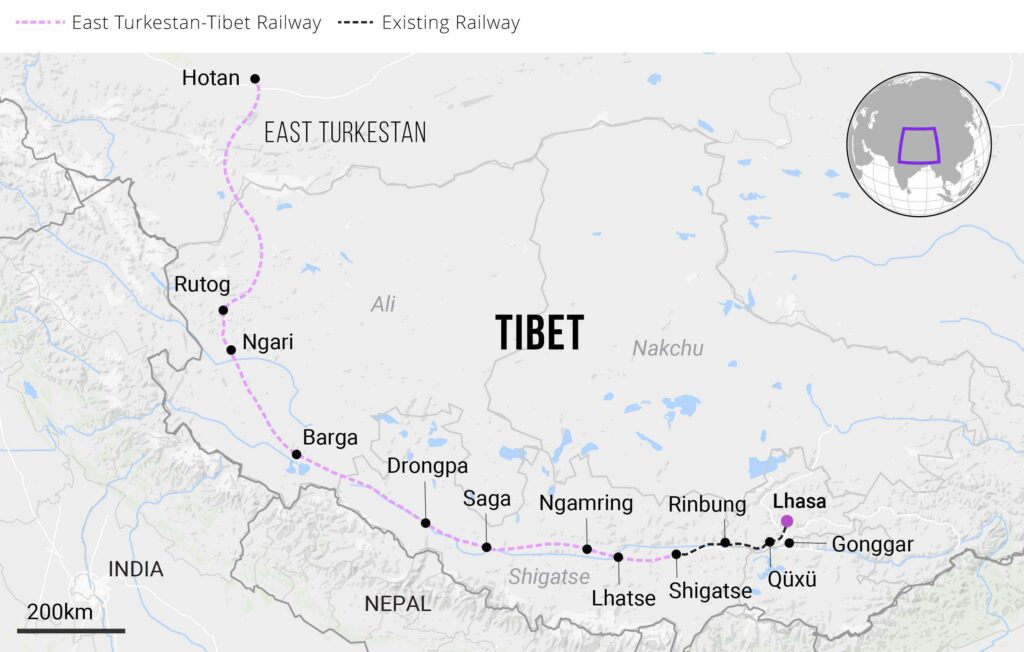(TibetanReview.net, Aug10’25) – China is to launch this year one of the world’s most ambitious railway projects with great strategic value that would link the resource-rich, occupied territories of East Turkestan (Chinese: Xinjiang) and Tibet by 2035. The report has emerged not long after China carried out the groundbreaking ceremony for building the world’s largest and potentially most dangerous hydro-power dam in Tibet.
Meant to build a railway line to link Hotan in East Turkestan and Lhasa in Tibet, a Xinjiang-Tibet Railway Company that is wholly owned by China State Railway Group has been formally registered with 95 billion yuan (US$13.2 billion) in capital, reported the scmp.com, citing Shanghai Securities News, Aug 9.
The company’s business scope is stated to include diversified operations as well, such as real estate development, tourism, catering, accommodation and international project contracting.
The route will join the existing Lhasa-Shigatse railway line with a new one from Hotan to Shigatse, forming a roughly 2,000km (1,240-mile) strategic artery linking northwestern and southwestern People’s Republic of China (PRC).
The planned railway – the Xinjiang-Tibet Railway – is one of four lines planned to connect Tibet Autonomous Region (TAR) with the rest of the PRC, with the other services linking the PRC’s western region to Qinghai, Sichuan and Yunnan provinces.
While the Qinghai-Tibet line opened amid much fanfare way back in 2006 and remains up and running, construction is at different stages of completion on the other two.
“This ambitious project aims to establish a 5,000km plateau rail framework centred on Lhasa by 2035,” the report quoted Hubei-based Huayuan Securities as saying in a research note on Aug 8.

The report noted that the project’s registered capital represents only initial funding, not the total project costs. For example, the 1,800km Sichuan-Tibet Railway required an estimated 320 billion yuan to build, Likewise, the cost of building the 1956km Qinghai-Tibet Railway was estimated to be 319.8 billion yuan (US$46.6 billion).
* * *
The project presents enormous engineering challenges but is of great strategic importance to China. Parts of the route will run near the Tibet-India Line of Actual Control, the de facto border between the two countries, giving it defensive importance in a frontier area with less infrastructure than the rest of the PRC, the report noted.
The route will have an average elevation of over 4,500 metres, and pass through the Kunlun, Karakoram, Kailash and Himalayan mountain ranges, going through glaciers, frozen rivers and permafrost.
The report noted that winter temperatures on the Tibetan Plateau can plunge to -40 degrees Celsius (-40 Fahrenheit), with oxygen levels at just 44% of inland regions.
Along with the engineering challenges, the project team will have to cope with accelerated machinery wear, soaring logistics costs, and environmental conservation needs, the report said.
Like China’s other ambitious infrastructure projects in Tibet, the Xinjiang-Tibet Railway project was conceived decades ago. It was planned in 2008, when it was included in the revised “Medium and Long-Term Railway Network Plan” approved by the National Development and Reform Commission, China’s top economic planner, the report noted.
Key milestones were stated to include the May 2022 launch of survey and design tenders for the Hotan-Shigatse section.
The report cited China’s Ministry of Transport officials as confirming in April that construction was expected to get underway this year.


